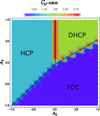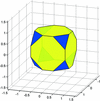issue contents
September 2017 issue

Cover illustration: The field of computational mechanics allows order and disorder in crystallography to be treated on an equal footing. Ordering is viewed as an information-processing dynamic capable of storing, transmitting and processing information. Statistical complexity, a measure of the resources used by the computational system, is plotted as function of the interaction parameters in a finite-range model describing polytypism in close-packed structures. Interaction is taken to occur between actual layers of the stacking arrangement. [Rodriguez-Horta et al. (2017). Acta Cryst. A73, 377-386].
obituaries




 journal menu
journal menu


























